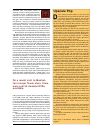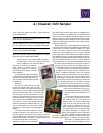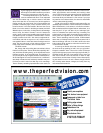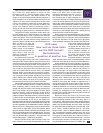
dot’s looks. Maybe, on a deeper level, he senses
her own need to shed her obsession, but all we
hear from him is that she’s beautiful. Maybe in
the 1920s, when Puccini composed the piece, a
preoccupation like that made more sense, but
now it sounds silly. “Jeez, Cal! I know you like bimbos, but
stay away from this one!” Still, this is all we have to go on, and
when the singer in the title role is dowdy, without even the
star-power that can override mere looks, Turandot as drama
falls apart.
What did grip me, though, was the production. I would
have said, up to now, that there’s nothing really Chinese about
Turandot. And why would there be? Yes, Puccini conscien-
tiously used Chinese folk songs in his score, but what did he
really know about China? What did any Westerner, besides a
few scholars and unusually open-minded travelers, really
know? China, in this opera, serves (or so I used to think)
merely as an exotic locale for a pre-Hollywood spectacular,
much as Egypt serves in Verdi’s Aïda, or, reaching heights of
grand absurdity, the American frontier, complete with Indi-
ans, did in an earlier Puccini work, La fanciulla del west
(“The Girl of the Golden West”).
But now I’m not so sure. This production, first of all, is
grand enough to suit the opera, whose music – a direct ances-
tor, I’d think, of Hollywood scores for epic films – proclaims
its size, and gilded (if not precisely golden) glitter. Conductor
Zubin Mehta even jokes, in the “making of,” that the opera
tucks into a tiny corner of the staging. Hordes of Chinese
extras come on stage, along with dancers, and the Western
singers in the leading roles are costumed with unheard-of
sumptuousness. Even Liú, who has crossed deserts and
begged for coins in the street, is wearing clothes lavish
enough to bankrupt a small city; her nails flash with mani-
cured splendor. Somehow, instead of making the work seem
silly, all this helps it make sense. “It’s only a fable,” the pro-
duction seems to tell us, with surprising gentleness, consider-
ing its size. Some of the Chinese effects are brilliant, even
touching. In the first scene, there’s a chorus about the rising
moon; onstage we see a corps of Chinese dancers, wearing
long white sculpted robes that shiver in the midnight wind.
Touches like these even give the opera depth it wouldn’t nor-
mally have, perhaps because the visual imagery takes the
grand suggestions in the music to a higher and more truthful
plane. Whether Puccini’s vision was surprisingly Chinese, or
whether Zhang Yimou picked Chinese imagery that would
complement the music, I don’t know. (And don’t look to the
“making of” for him to tell us; nothing there goes even half an
inch below the surface.) But the whole thing adds up to much
more than I would have expected.
And in the third act, even the operatic performance starts
to be good. I’m not quite sure what makes that happen. Zubin
Mehta gets some credit. He’s a conductor somewhat reviled
these days by critics, ever since his hollow tenure in the Eight-
ies with the New York Philharmonic. But there’s no way to
fault him here. His Turandot (he conducts the Maggio Musi-
cale Fiorentino orchestra from Italy) is spacious, lyrical, and
suitably grand. And Barbara Frittoli helps to bring the act to
life. She’s the one principal, remember, who can really sing
her part, and here, given her biggest scene (her sacrifice), she
loses all her caution, and wakes the drama up.
But Sergeij Larin gets a medal, too, for his “Nessun
dorma.” He doesn’t interact much, I’ve said, but here he does
not have to; the aria is sung alone on stage, for what seems to
be his favorite dramatic partner, himself. And his voice rings
out. I have to admit that I’m suspicious of that ringing sound,
because the entire sound of the performance is artificial. It
had to be; the event took place outdoors, in a huge open
space. Obviously, the singers are miked, and the “making of”
shows us exactly how, as well as revealing, for those who
catch a fleeting moment when Larin tests a mike, that his
singing is beefed up with some reverb. “Beefing up” might not
be the intention; the idea might simply be to give the sound
some ambience. But there’s nothing like reverb to make a
rough voice a little smoother, and a small voice a little bigger.
Larin doesn’t have the trumpet sound a Calaf really needs;
worse, when we hear him in a practice studio in the “making
of,” he’s rougher than he sounds in the performance. Give him
the benefit of every doubt; grant that he’s just rehearsing, that
he could have been hoarse, or just generally having a bad day.
But still I think that amplification helped him. Maybe, know-
ing it was there, he sang more lightly than he would have, not
pushing his voice, but letting it blossom naturally. If then he’s
not loud enough, there’s a simple solution: Turn up the vol-
ume, which would have been simplicity itself to do. In the
“making of,” we see a giant mixing console, with separate
channels, clearly marked, for every singer.
And yet in the end, I was moved (even though Puccini died
before finishing the opera, and someone else had to write the
final scene, someone who couldn’t find the right, convincing
sound for Tu r a n d o t ’s crucial transformation). And so, I find I
recommend this DVD – though if you’ve never heard the opera,
you might supplement it with either of two classic audio-only
recordings, the RCA with Jussi Björling as Calaf, or the EMI
with Franco Corelli; both have Birgit Nilsson, spectacularly the
right kind of voice, as Turandot. (Avoid the set with Pavarotti
and Joan Sutherland, spectacularly the wrong sort of voices.
Pavarotti sings “Nessun dorma” nicely, but he’s far too light and
lyrical for this heroic role; don’t be fooled.)
About the goodies: I’ve already said the “making of” won’t
tell you anything deep; I trust you’re not surprised. The syn-
opsis, read out loud against snapshots from the performance,
is pompous in English, much more friendly in the other lan-
guages; it’s adequate, and not a word too long. There’s a PCM
audio-only track, again with snapshots, if you want that. What
the package badly needs, but doesn’t have, is a complete
libretto of the opera, on screen or in a booklet, so listeners
can prep themselves and then watch without subtitles. The
whole package needed much more careful editing. I’ve men-
tioned the two spellings of the tenor’s name, but there are
odd, no doubt accidental omissions. We’re correctly told, for
instance, that Zhang Yimou is a distinguished film director,
but we don’t learn the names of any of his films.
The box contains a booklet, with the kind of random
scholarly essay on the opera’s origins that might be found
with any new recording. We didn’t need that; we needed what
I said was missing from the “making of,” some comment from
Zhang or from a Chinese scholar on how Chinese the opera
seems, how it feels to be a Chinese person working with it.
The musical performance, with its strengths and obvious
weaknesses, is what it is. But if someone had worked one-
fourth as carefully on the DVD package as Zhang (and his
choreographer and costumer) worked on the staging, this first
big-time classical DVD – welcome as it is in many ways –
could have been better.


















